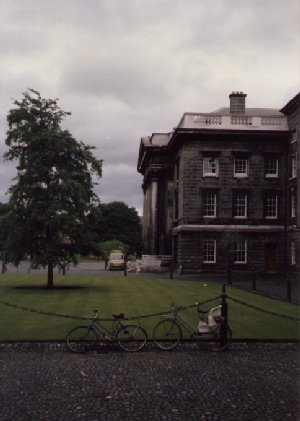|
Trinity College Dublin was founded in 1592 by Elizabeth 1st on the site of
an Augustinian monastery. It is the sole college of Dublin
University. The oldest surviving part of the college is a row of red-bricked
buildings known as the Rubrics which were begun in 1700 and are now used
for student digs. The front gate leads to the cobbled Parliament Square which
is dominated by the Campanile of 1853. Around the grounds are many statues
of and /or by famous people. Beyond the front square is
the Old Library Building. The Long room, the reading room, stretches
210 ft, is 41 ft wide and has a barrel vaulted ceiling. It was finished
in 1732 and houses more than 200,000 of the colleges collection of books.
Some of the famous people who attended Trinity college are Edmund Burke (1729-97), Oliver Goldmith, Jonathan Swift, Samuel Beckett, Oscar Wilde, and Bram Stoker (who wrote Dracula).
In the library of Trinity College Dublin, are
kept some of the best preserved manuscripts of the 8th and
9th centuries. These were copies of the Gospels painstakingly written
and illustrated by teams of monks. The Book of
Kells is probably the most famous. This is an illuminated latin manuscript
of the four Gospels dating from about 800 AD. It was the work of a
team of monks in Kells (hence the name). It has 680 pages and all but
two are coloured. Key pages such as those illustrating the Nativity
or the Crucifixion are given full pages, while other pages have decorated
letters filled with birds, animals and spiral patterns.
The 7th century Book of Durrow is also in Trinity
Library said to have been written at Durrow Abbey in about AD 675. It is
one of the earliest manuscripts to have a carpet page, that is a page completely
covered in pattern and colour. It disappeared The 8th century book of Dimma is also here as is St. Patricks Harp which is the oldest surviving harp in Ireland. The library is open to the public and there is a good tourist shop. |
